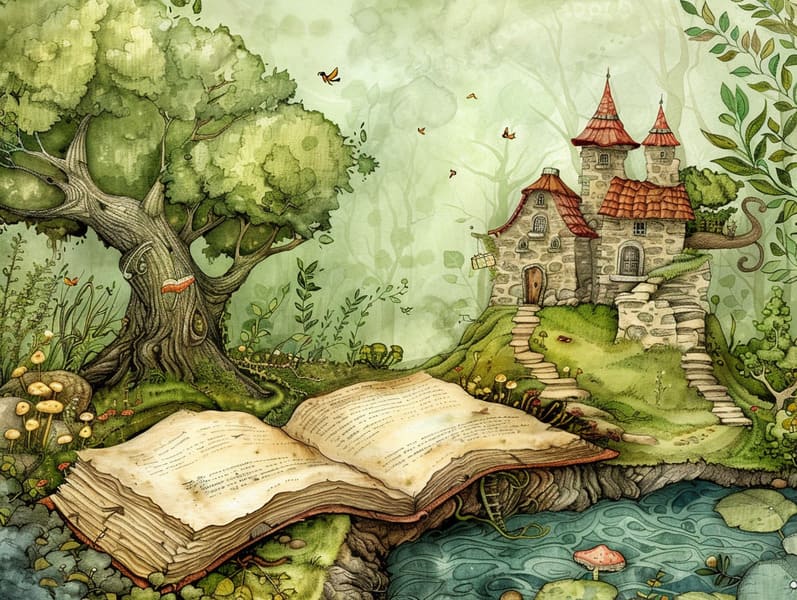The Evolution of Traditional Fairy Tales and Their Steadfast Attraction.
The Evolution of Traditional Fairy Tales and Their Steadfast Attraction.
Blog Article

Children's fairy tales have legendary status. These stories have been relayed from one generation to the next centuries before they were ever published. They originated from a variety of societies, including Asian traditions. They were initially passed along among older generations, often carrying themes and messages aligned with the societal norms and beliefs of the time.
The Grimm brothers, Jacob and Wilhelm, were among the first to assemble many of these beloved narratives. Their published works, "Grimm's Fairy Tales," included classics like "The Little Glass Slipper," "Little Brother and Little Sister," and "The True Story of Snow White," which have since become cornerstones in the world of children's fairy tales. Similarly, Hans Andersen's whimsical narratives, such as "The Story of the Little Mermaid," and "The Duckling that Could," have enchanted hearts worldwide, securing their place in the pantheon of beloved fairy tales.
Despite being ancient, these stories remain as applicable as ever, especially as children's night stories. These fantastical tales are now available in numerous formats, including beautifully illustrated books, captivating animations, and online fairy tales.
Their lasting presence can be connected to several delightful features:
Valuable Lessons: Timeless fairy tales often present important moral lessons. Fairy tales like "The Boy Who Cried Wolf" teach the significance of truthfulness, while "The Tale of the Tortoise and the Hare" demonstrate the virtues of steadfastness and humility. These narratives offer the young clear distinctions between correct and incorrect, helping to shape their moral compass in a mild yet important way.
Empathy and Understanding: Classic fairy tales frequently depict heroines facing challenges and problems, motivating listeners to identify with their struggles and applaud their triumphs. For instance, "Beauty's Beast" teaches us the merit of seeing beyond the surface to acknowledge the inner being of a being, enhancing kindness and discernment.
Cultural Recognition: Many fairy tales are deeply ingrained in the cultural contexts from which they arose. Understanding these narratives can provide illuminating insights into different cultures, fostering a sense of world awareness and comprehension.
Imagination and Innovation: The mythical elements in old fairy tales—mythical creatures—kindle children’s imaginative ideas. These fairy tales transport readers to magical realms, unleashing creative thinking and a sense of amazement that endures a lifetime.
Traditional fairy tales are not only mesmerizing but also informative. They function as whimsical tools in fostering various cognitive and affective skills in young readers. When classic fairy tales are recited, they nurture communication skills by offering new lexicon and elaborate sentence structures. This practice also strengthens auditory perception and attention span, as little ones focus on every detail, excited to see what happens next.
Furthermore, conversing about the themes and characters of classic fairy tales can develop problem-solving abilities and thought processes. The young are taught to detect patterns, make predictions, and grasp cause and effect. These reflections also help kids communicate their thoughts and feelings, nurturing their emotional intelligence.
In today’s technological era, the prevalence of digital storybooks has made these website fairy tales more available than ever. Digital sites and web apps share large libraries of Grimm's fairy tales that can be perused or played anytime, anywhere. Fairy tales spoken are particularly sought after, featuring an fun way for kids to immerse in these alluring stories. Narrated books and read-to-me videos guide characters and settings to life, often enhanced by whimsical musical scores and melodies that augment the narrative experience.
The timeless appeal of ancient fairy tales lies in their ability to shift to present eras while retaining their main lessons. Contemporary renditions of these stories often showcase more inclusive figures and modern settings, making them familiar to today’s audience. However, the essential messages of braveness, kindheartedness, and fair play remain unchanged, continuing to impact young readers of all ages.
Classic fairy tales also offer a sense of assurance and knowability. They deliver a systematic narrative with a unmistakable beginning, middle, and end, often concluding with the closure of conflicts and the triumph of righteousness over wickedness. This reliability can be solacing for young ones, gifting a sense of sturdiness in an ever-changing world.
Old fairy tales continue to delight and enlighten new generations, maintaining their splendor and value in modern society. As children's bedtime stories, they extend a perfect blend of charm and enlightenment, cultivating moral values, empathy, and creativity. The existence of online storybooks and the likability of fairy tales voiced make sure that these ancient stories remain within reach to new generations.
By conserving and making known these stories, we continue to pay tribute to the rich tapestry of fables and cultural heritage. Whether you are browsing a vividly illustrated book, exploring a electronic collection, or listening on an audio story, the magic of ancient fairy tales is always within reach. These fairy tales illustrate of the unwavering power of stories and its ability to join us across generations and cultures.
Be it you are exploring a vividly illustrated book, browsing a electronic collection, or listening on an sound book, the allure of ancient fairy tales is always within reach.
These narratives demonstrate of the lasting nature of storytelling and its ability to link us across generations and cultures, making a tie that enchants and educates alike.